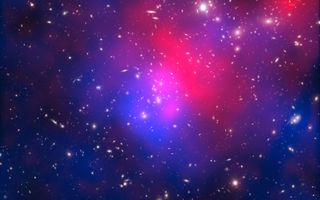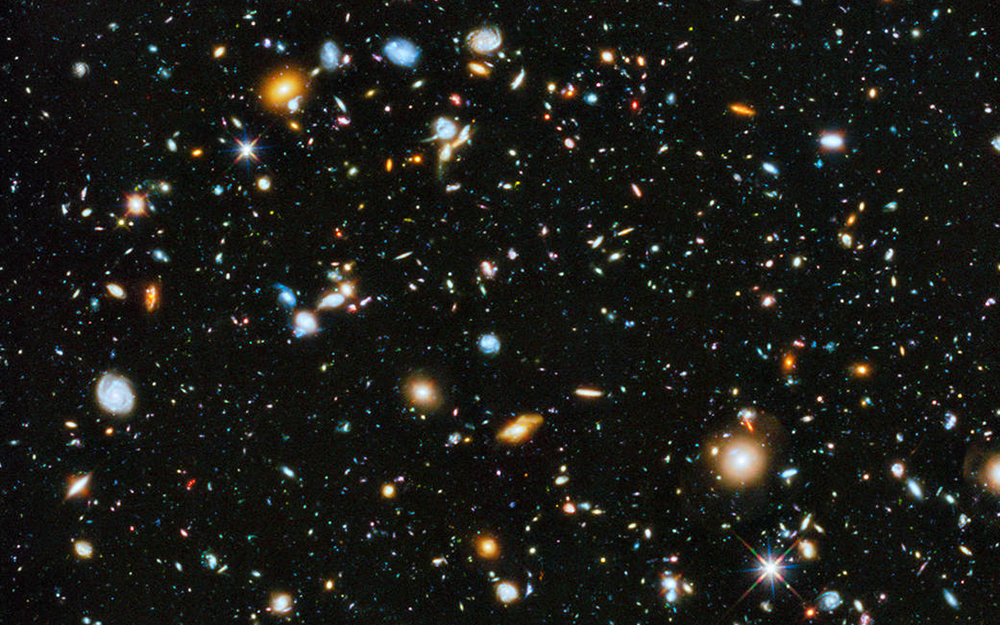What Is The Makeup Of Our Universe
What Is the Universe Fabricated of?

The universe is filled with billions of galaxies and trillions of stars, along with nearly uncountable numbers of planets, moons, asteroids, comets and clouds of dust and gas – all swirling in the vastness of space.
Simply if we zoom in, what are the building blocks of these angelic bodies, and where did they come from?
Hydrogen is the most common element plant in the universe, followed by helium; together, they make up most all ordinary matter. Simply this accounts for merely a tiny slice of the universe — almost 5%. All the rest is made of stuff that can't be seen and tin only be detected indirectly. [From Big Bang to Present: Snapshots of Our Universe Through Fourth dimension]
Mostly hydrogen
It all started with a Big Bang, about xiii.8 billion years ago, when ultra-hot and densely packed matter suddenly and rapidly expanded in all directions at in one case. Milliseconds later, the newborn universe was a heaving mass of neutrons, protons, electrons, photons and other subatomic particles, roiling at nearly 100 billion degrees Kelvin, co-ordinate to NASA.
Equally of matter that makes up all the known elements in the periodic tabular array — and every object in the universe, from black holes to massive stars to specks of space dust — was created during the Big Bang, said Neta Bahcall, a professor of astronomy in the Section of Astrophysical Sciences at Princeton University in New Bailiwick of jersey.
"Nosotros don't fifty-fifty know the laws of physics that would have existed in such a hot, dense environment," Bahcall told Live Scientific discipline.
Almost 100 seconds after the Big Blindside, the temperature dropped to a still-seething one billion degrees Kelvin. By roughly 380,000 years later, the universe had cooled enough for protons and neutrons to come together and class lithium, helium and the hydrogen isotope deuterium, while gratis electrons were trapped to course neutral atoms.
Considering there were so many protons zipping around in the early universe, hydrogen — the lightest chemical element, with just one proton and one neutron — became the near abundant chemical element, making up nearly 95% pct of the universe'due south atoms. Close to 5% of the universe'south atoms are helium, according to NASA. Then, about 200 one thousand thousand years subsequently the Large Bang, the commencement stars formed and produced the rest of the elements, which make upward a fraction of the remaining 1% of all ordinary thing in the universe.
Unseen particles
Something else was created during the Big Bang: night affair. "But we can't say what form it took, considering we haven't detected those particles," Bahcall told Live Science.
Dark matter can't be observed directly — however — but its fingerprints are preserved in the universe's first light, or the catholic microwave groundwork radiation (CMB), equally tiny fluctuations in radiation, Bahcall said. Scientists first proposed the existence of night matter in the 1930s, theorizing that nighttime thing'southward unseen pull must be what held together fast-moving galaxy clusters. Decades later, in the 1970s, American astronomer Vera Rubin found more indirect prove of dark matter in the faster-than-expected rotation rates of stars.
Based on Rubin's findings, astrophysicists calculated that dark matter — even though information technology couldn't be seen or measured — must make up a significant portion of the universe. But near xx years ago, scientists discovered that the universe held something even stranger than nighttime matter; dark energy, which is thought to be significantly more abundant than either thing or dark matter. [Gallery: Dark Affair Throughout the Universe]

An irresistible force
The discovery of dark free energy came about because scientists wondered if at that place was enough dark matter in the universe to cause expansion to sputter out or reverse direction, causing the universe to collapse inward on itself.
Lo and behold, when a team of researchers investigated this in the belatedly 1990s, they plant that not just was the universe not collapsing in on itself, it was expanding outward at an ever faster rate. The group adamant that an unknown strength — dubbed dark energy — was pushing confronting the universe in the apparent void of space and accelerating its momentum; the scientists' findings earned physicists Adam Riess, Brian Schmidt and Saul Perlmutter the Nobel Prize in Physics in 2011.
Models of the forcefulness required to explain the universe'southward accelerating expansion rate suggest that dark energy must brand up between lxx% and 75% of the universe. Dark thing, meanwhile, accounts for about 20% to 25%, while and so-called ordinary affair — the stuff we can actually encounter — is estimated to make up less than five% of the universe, Bahcall said.
Considering that dark energy makes up about three-quarters of the universe, understanding information technology is arguably the biggest challenge facing scientists today, astrophysicist Mario Livio, then with the Infinite Telescope Science Constitute at Johns Hopkins University in Baltimore, Maryland, told Live Science sister site Infinite.com in 2018.
"While dark energy has not played a huge function in the evolution of the universe in the past, information technology will play the dominant role in the evolution in the future," Livio said. "The fate of the universe depends on the nature of dark free energy."
- Across Higgs: 5 Elusive Particles That May Lurk in the Universe
- 11 Fascinating Facts About Our Milky Manner Galaxy
- The 11 Biggest Unanswered Questions Well-nigh Dark Matter
Originally published on Alive Science .
Source: https://www.livescience.com/what-is-the-universe-made-of.html
Posted by: ryanhento1951.blogspot.com


0 Response to "What Is The Makeup Of Our Universe"
Post a Comment